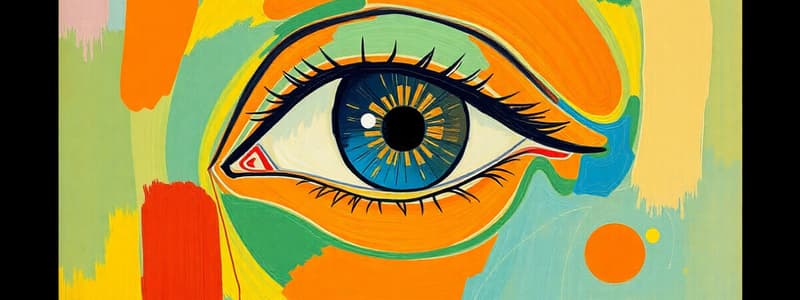Podcast
Questions and Answers
Which medication is associated with ocular side effects?
Which medication is associated with ocular side effects?
- Warfarin
- Corticosteroids (correct)
- Lisinopril
- Metformin
Which of the following medications is NOT mentioned as having ocular side effects?
Which of the following medications is NOT mentioned as having ocular side effects?
- Amlodipine (correct)
- Quinidine
- Lovastatin
- Pyridostigmine
What is a potential ocular side effect of medications such as pyridostigmine and quinidine?
What is a potential ocular side effect of medications such as pyridostigmine and quinidine?
- Night blindness
- Increased intraocular pressure
- Color blindness
- Blurred vision (correct)
Which combination includes only medications indicated to have ocular side effects?
Which combination includes only medications indicated to have ocular side effects?
Which of the following pairs both include medications associated with ocular side effects?
Which of the following pairs both include medications associated with ocular side effects?
What should be noted when palpating the lacrimal apparatus?
What should be noted when palpating the lacrimal apparatus?
What condition is indicated by expressed drainage from the puncta during palpation?
What condition is indicated by expressed drainage from the puncta during palpation?
Which of the following is NOT typically associated with dacryocystitis?
Which of the following is NOT typically associated with dacryocystitis?
What is the primary technique used to assess the lacrimal apparatus?
What is the primary technique used to assess the lacrimal apparatus?
What should NOT be observed when palpating the nasolacrimal duct?
What should NOT be observed when palpating the nasolacrimal duct?
What is the purpose of palpation in the context of assessing the lacrimal apparatus?
What is the purpose of palpation in the context of assessing the lacrimal apparatus?
During the assessment of the cornea, what is considered a normal finding?
During the assessment of the cornea, what is considered a normal finding?
Which of the following is NOT typically assessed during the examination of the external eye?
Which of the following is NOT typically assessed during the examination of the external eye?
What abnormal finding may indicate a problem with the cornea?
What abnormal finding may indicate a problem with the cornea?
What does the assessment of the lacrimal apparatus primarily focus on?
What does the assessment of the lacrimal apparatus primarily focus on?
What can exposure to irritants or obstruction affect in relation to the eyes?
What can exposure to irritants or obstruction affect in relation to the eyes?
What type of discharge is indicated by the question regarding eye discharge?
What type of discharge is indicated by the question regarding eye discharge?
Which of the following is a symptom that can arise from the obstruction of the lacrimal apparatus?
Which of the following is a symptom that can arise from the obstruction of the lacrimal apparatus?
When assessing for eye discharge, what is an important characteristic to note?
When assessing for eye discharge, what is an important characteristic to note?
Which condition may cause obstruction in the lacrimal apparatus?
Which condition may cause obstruction in the lacrimal apparatus?
What are some potential treatments for vision problems?
What are some potential treatments for vision problems?
Which of the following might indicate that a client is dissatisfied with their treatment for vision problems?
Which of the following might indicate that a client is dissatisfied with their treatment for vision problems?
What is an example of a surgical treatment for vision problems?
What is an example of a surgical treatment for vision problems?
What type of treatment might not require any surgical intervention?
What type of treatment might not require any surgical intervention?
Which treatment might a client consider if they were unsatisfied with glasses?
Which treatment might a client consider if they were unsatisfied with glasses?
Flashcards are hidden until you start studying
Study Notes
External Eye & Lacrimal Apparatus Assessment
-
Lacrimal Apparatus:
- Discharge: Ask about eye discharge, besides tears, from one or both eyes. Describe qualities of the discharge.
- Obstruction: Investigate if eye discharge is due to irritants or obstruction of the lacrimal apparatus.
- Medications: Determine if any medications being used can cause ocular side effects, including corticosteroids, lovastatin, pyridostigmine, or quinidine.
- Palpation: Palpate the lacrimal apparatus from the puncta to the nasolacrimal duct.
- Normal Findings: No drainage should be expressed from the puncta when palpating the nasolacrimal duct.
- Abnormal Findings: Expressed drainage from the puncta when palpating the nasolacrimal duct indicates blockage.
- Dacryocystitis: Consider this diagnosis if a blockage is found.
-
Cornea and Lens:
- Inspection: Inspect the cornea and lens.
- Normal Findings: The cornea is clear and smooth.
- Abnormal Findings: Note any roughness or dryness of the cornea and lens.
- Inspection: Inspect the cornea and lens.
Studying That Suits You
Use AI to generate personalized quizzes and flashcards to suit your learning preferences.





